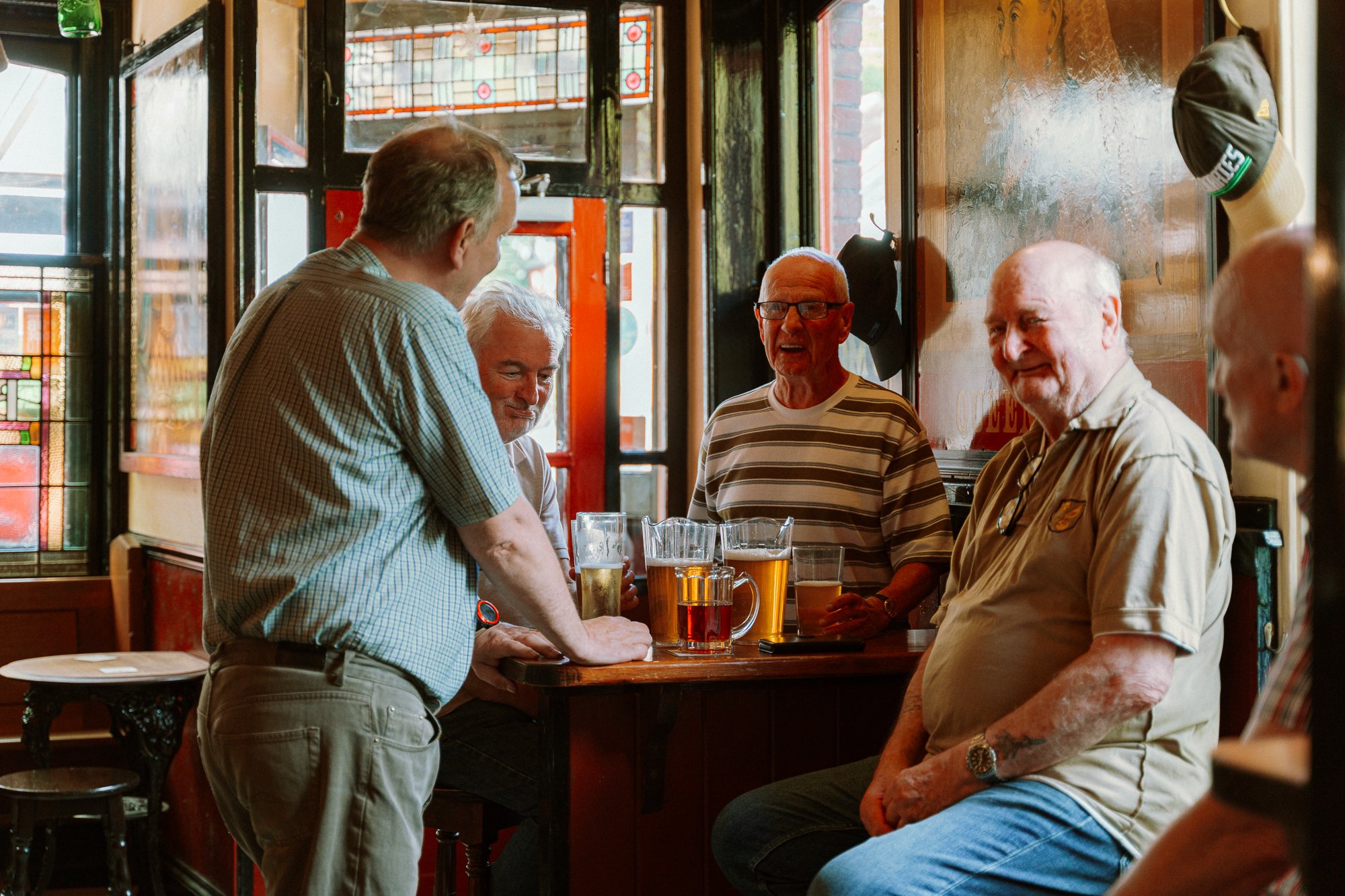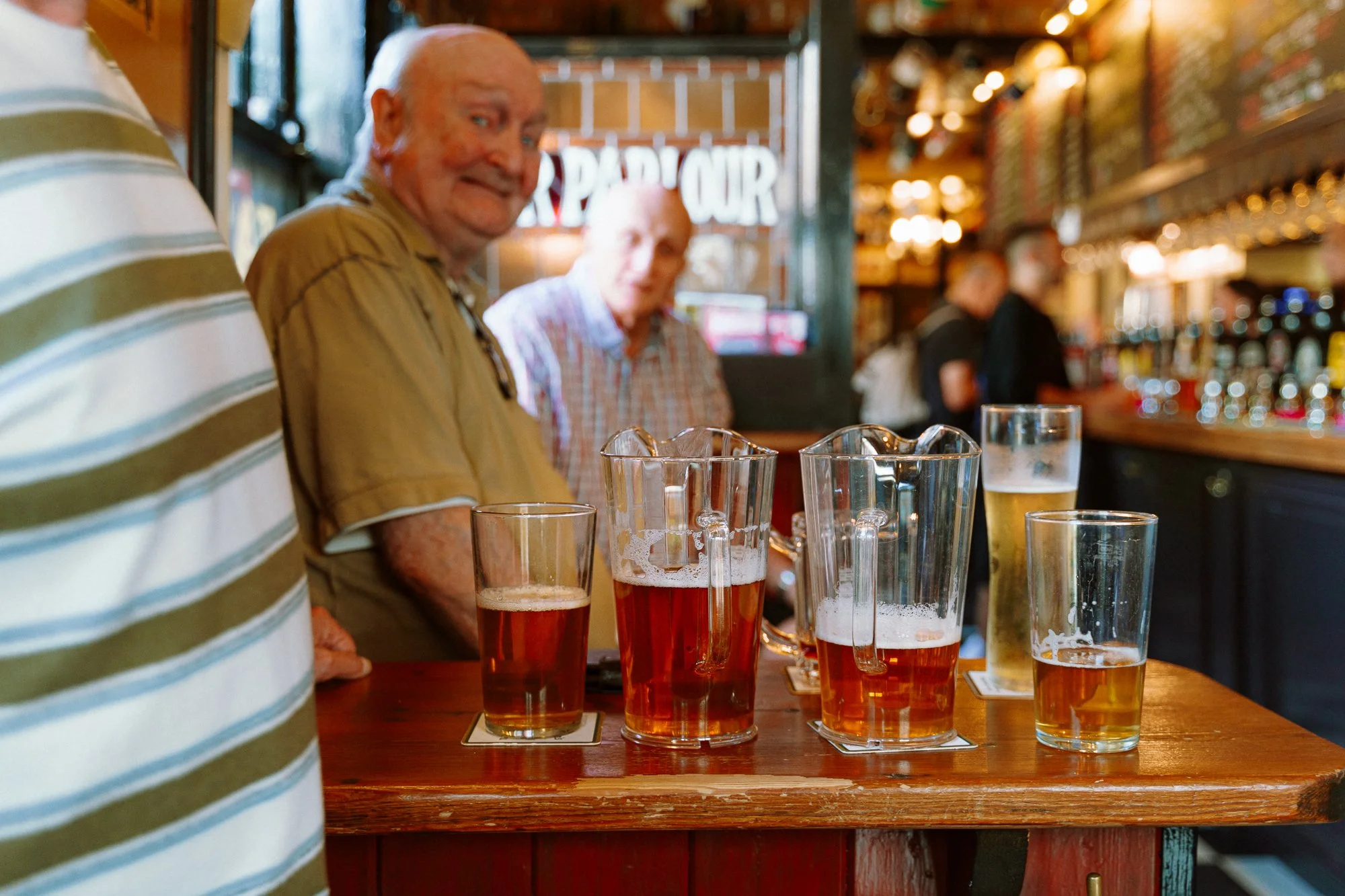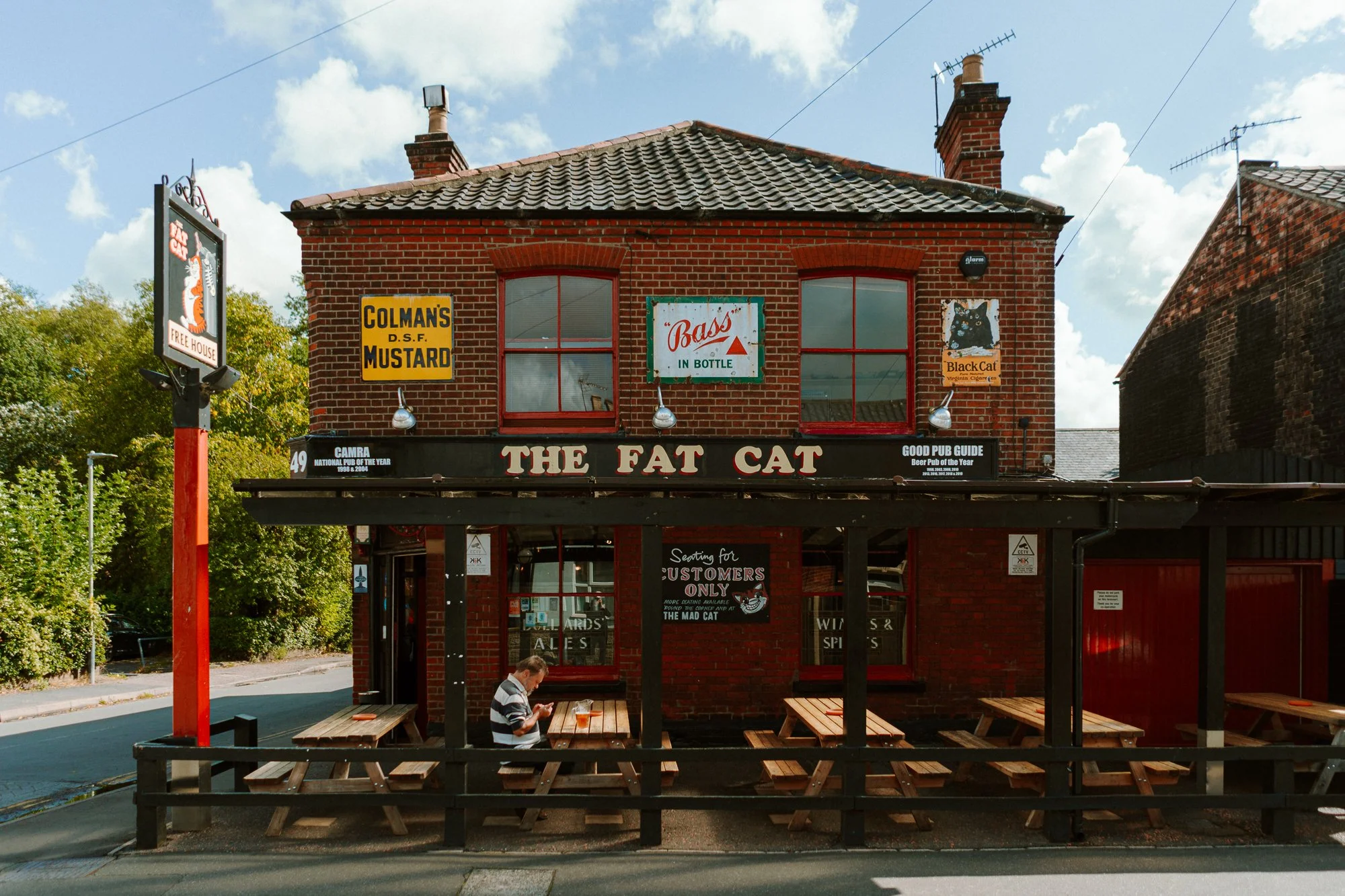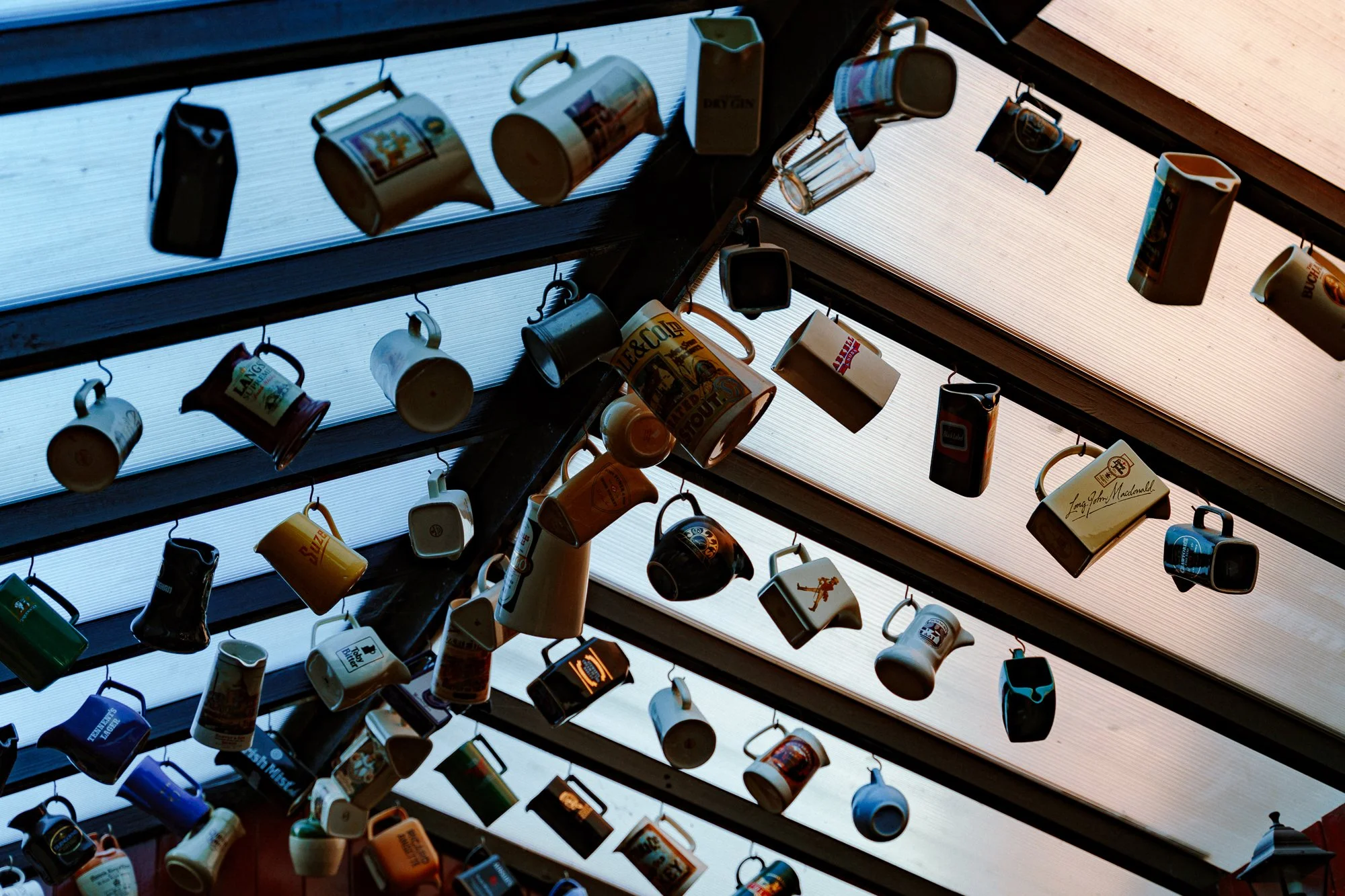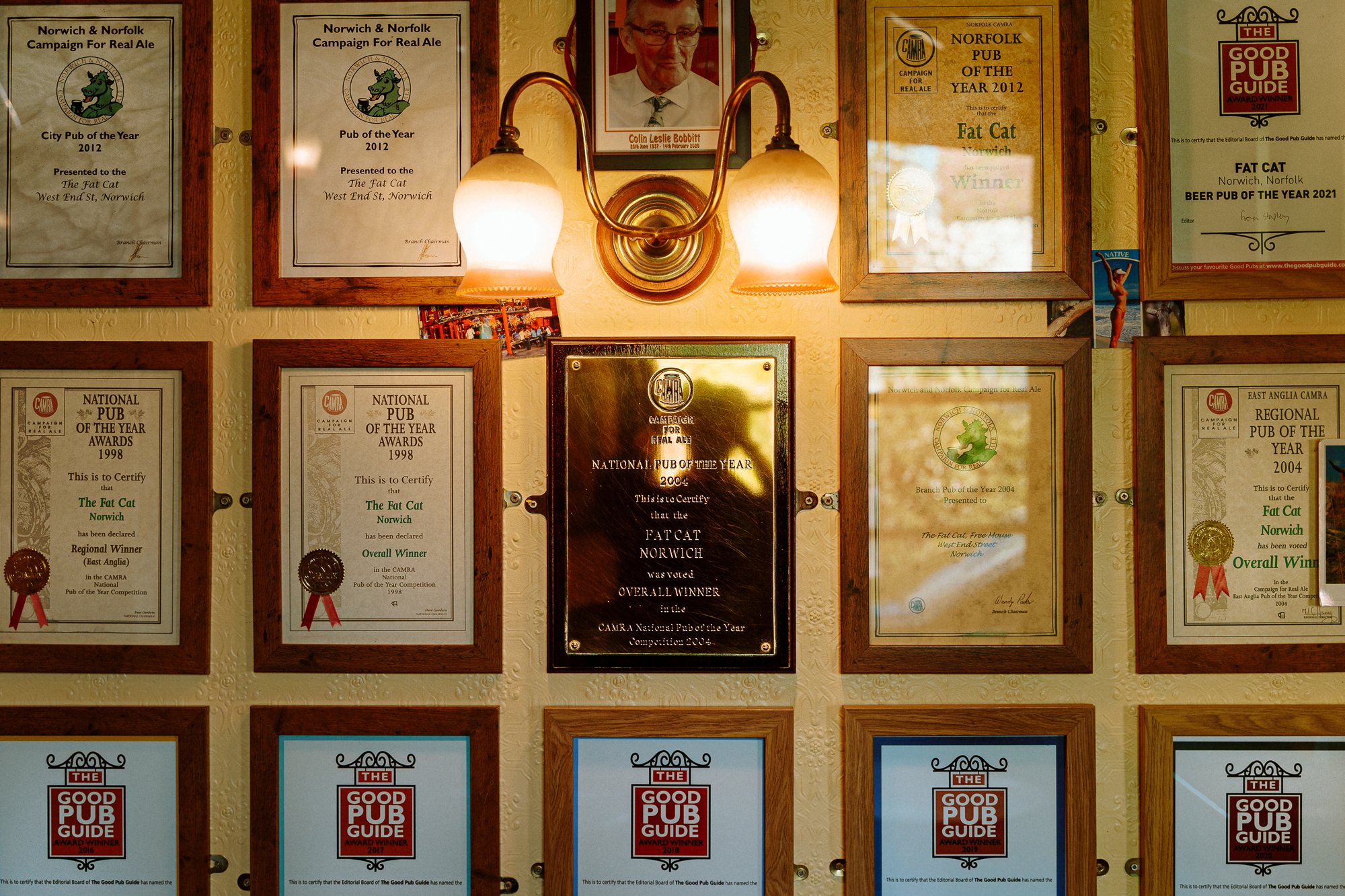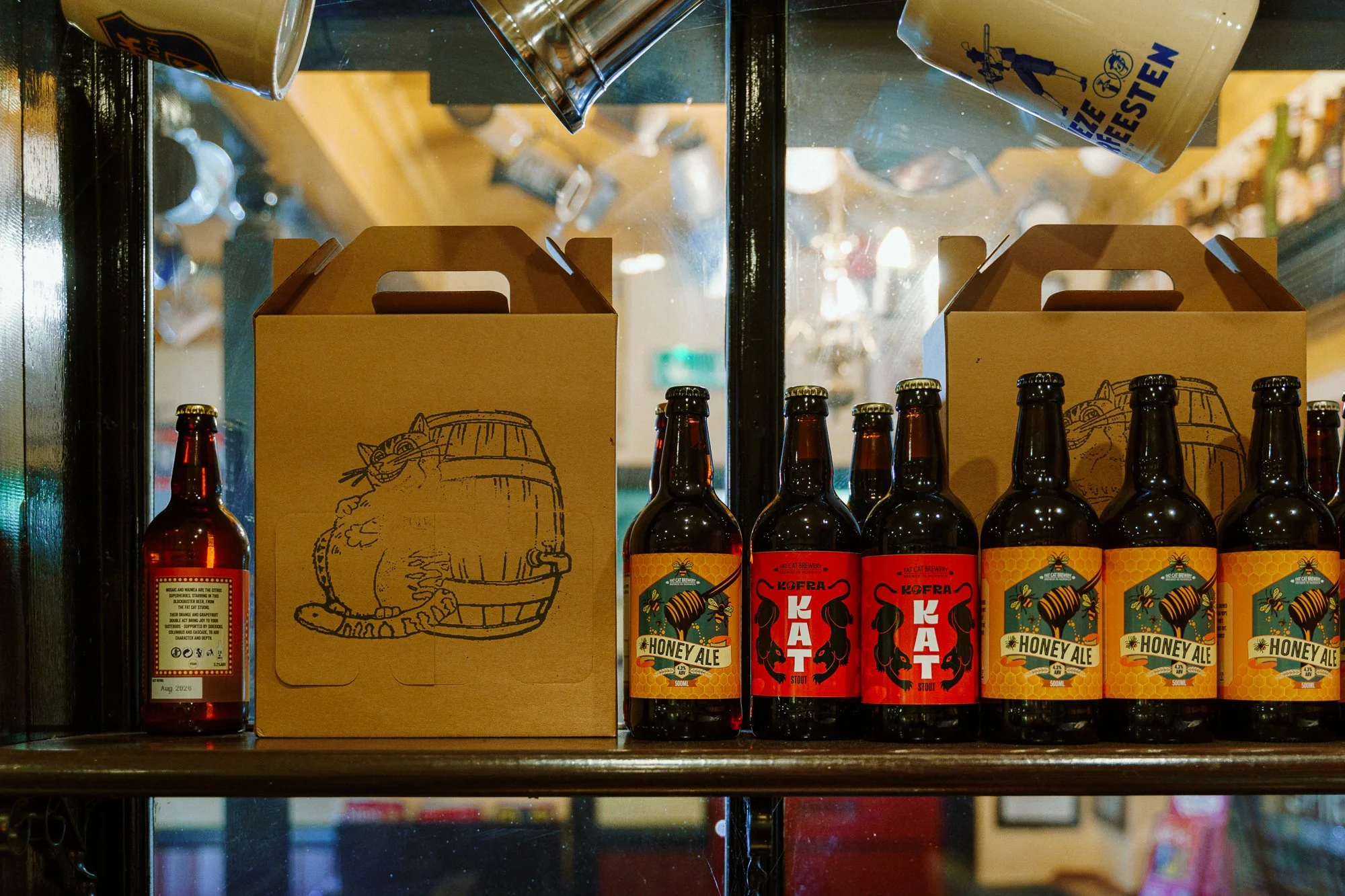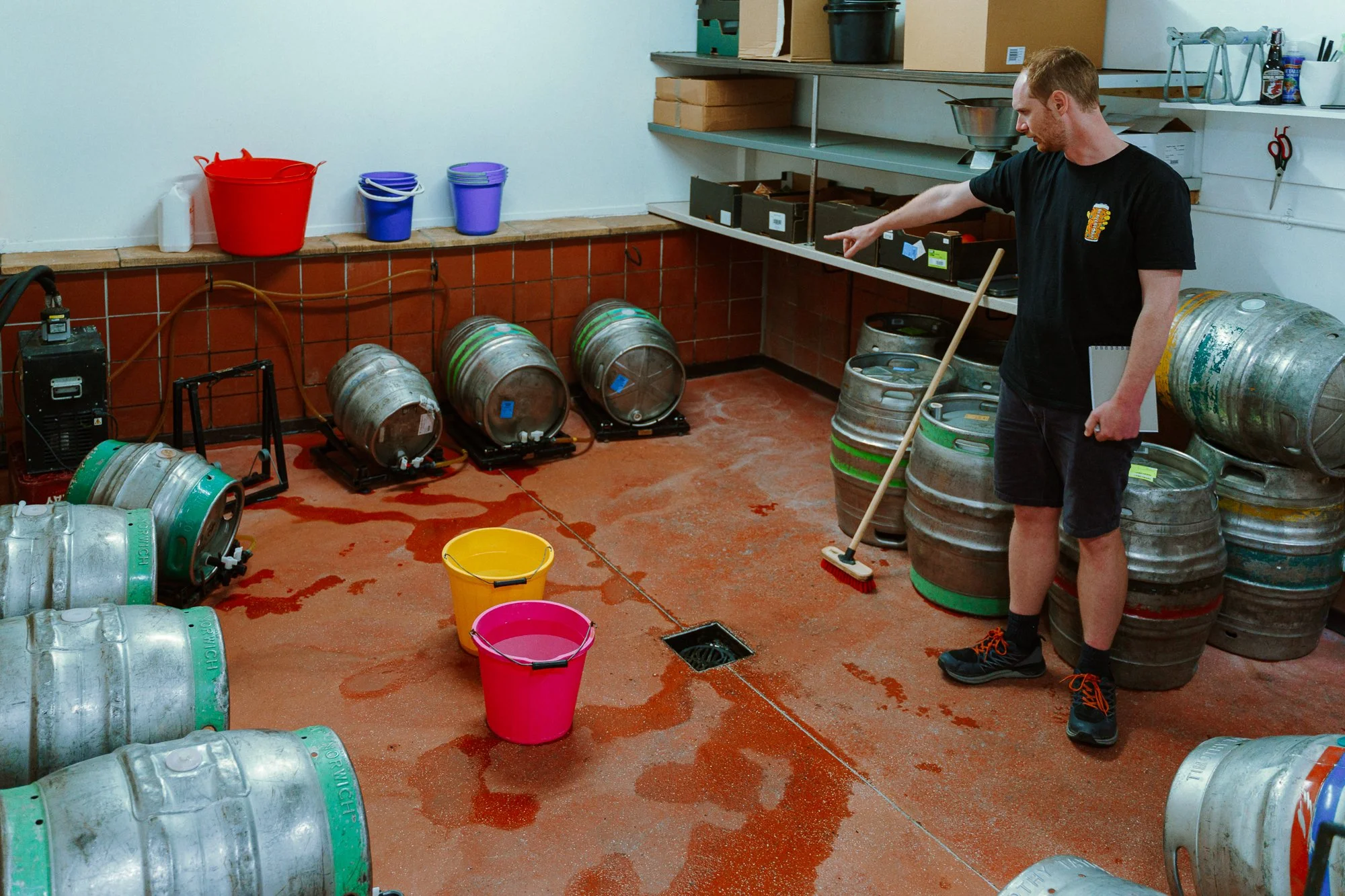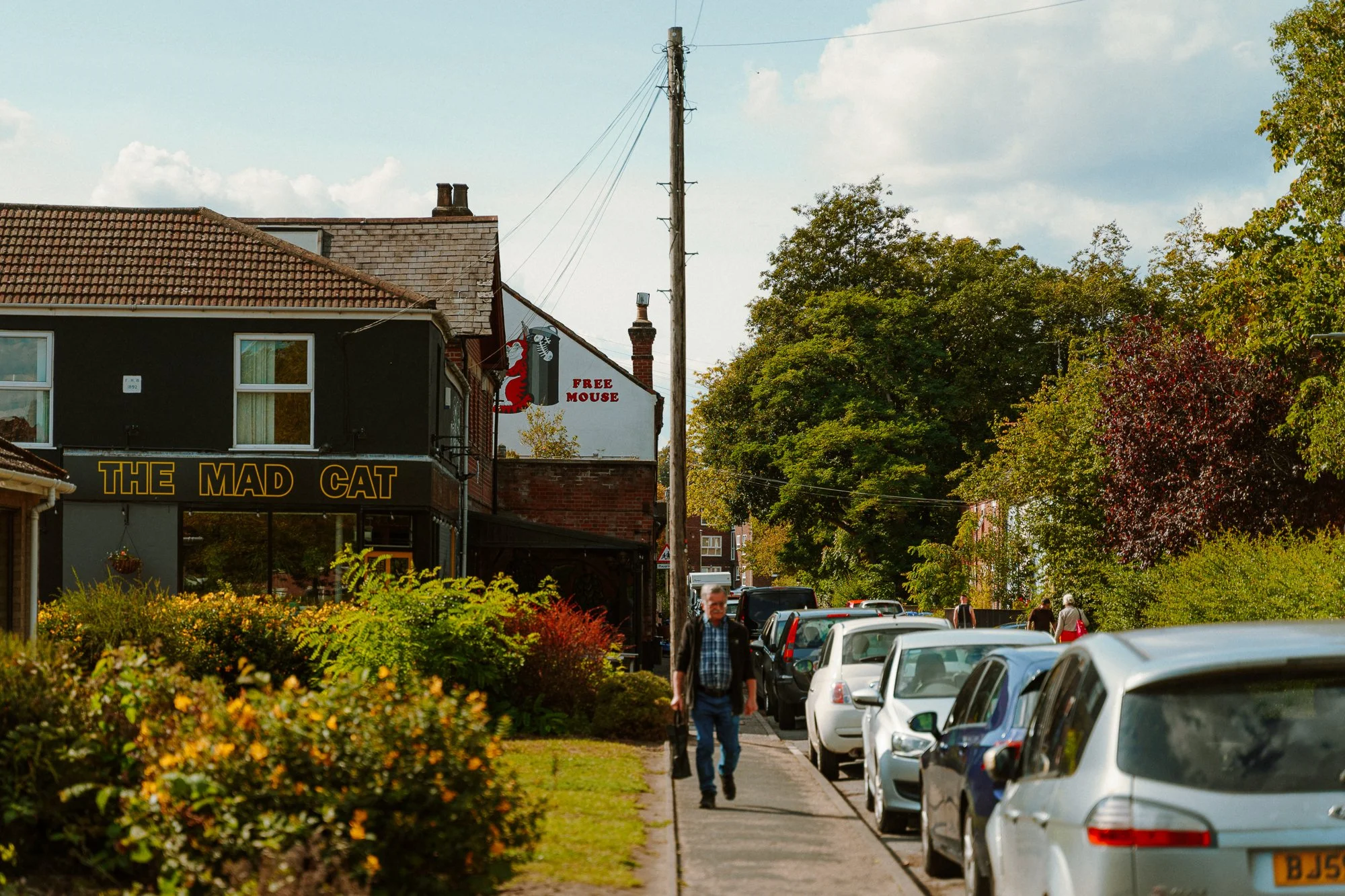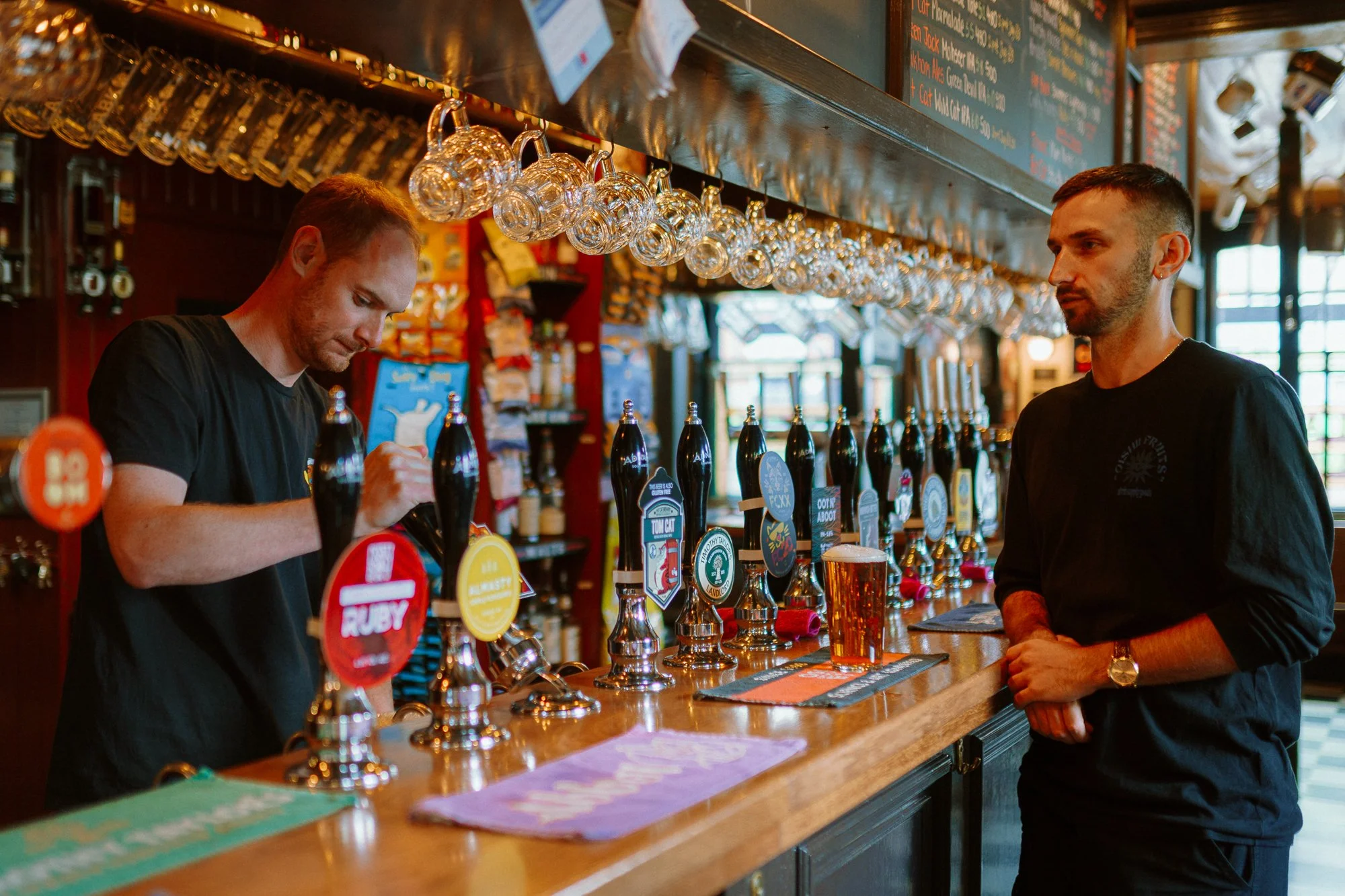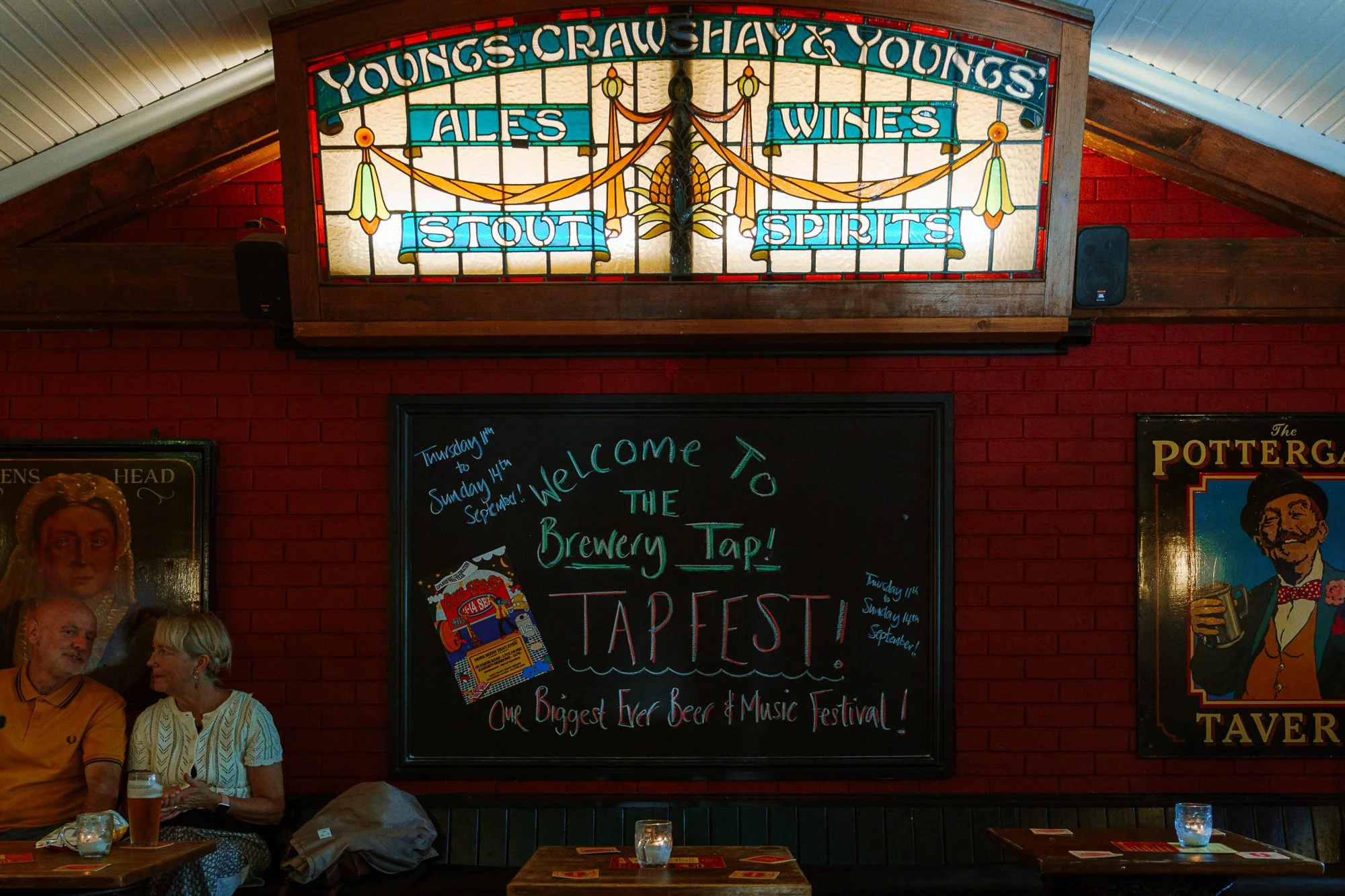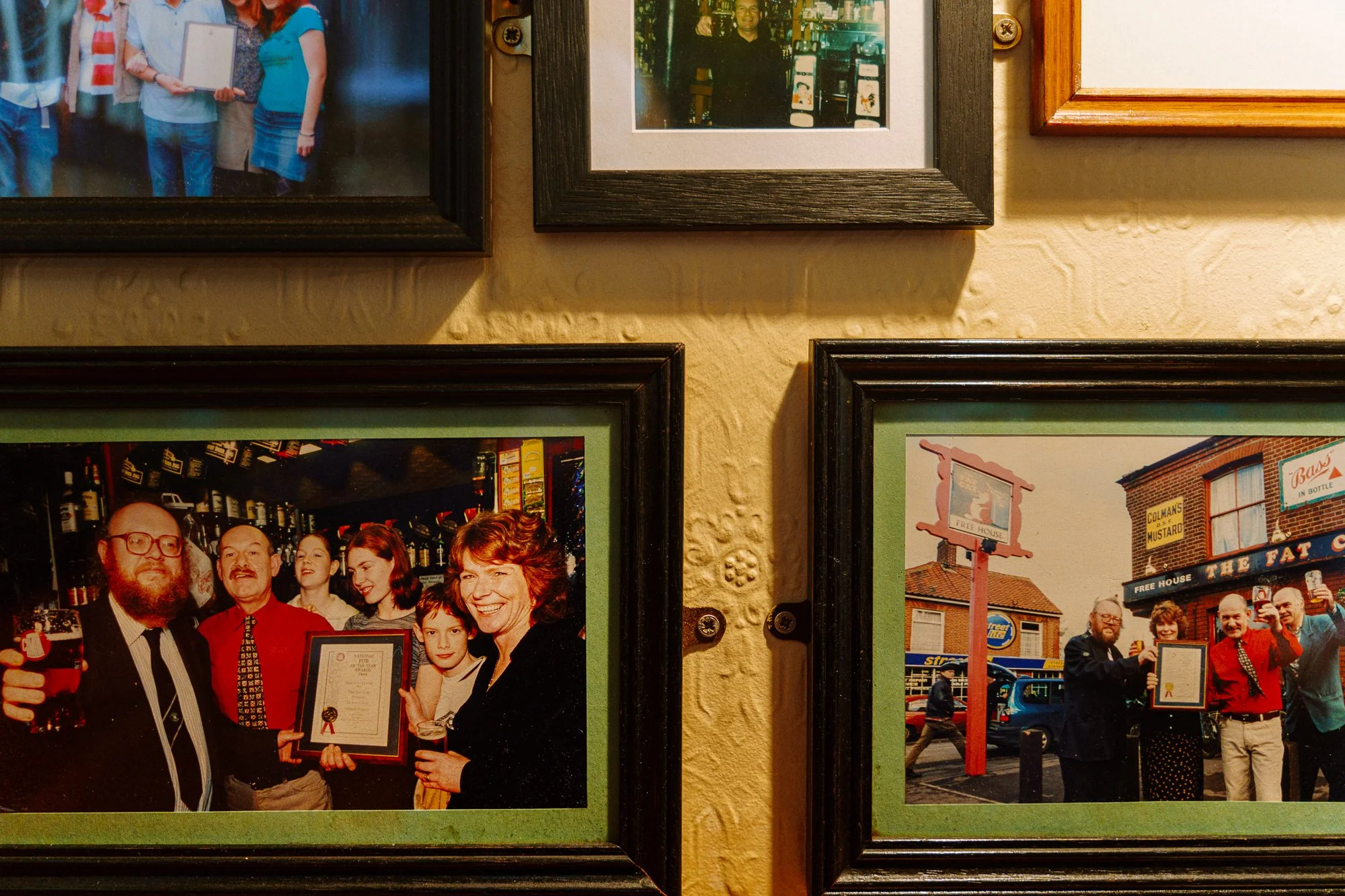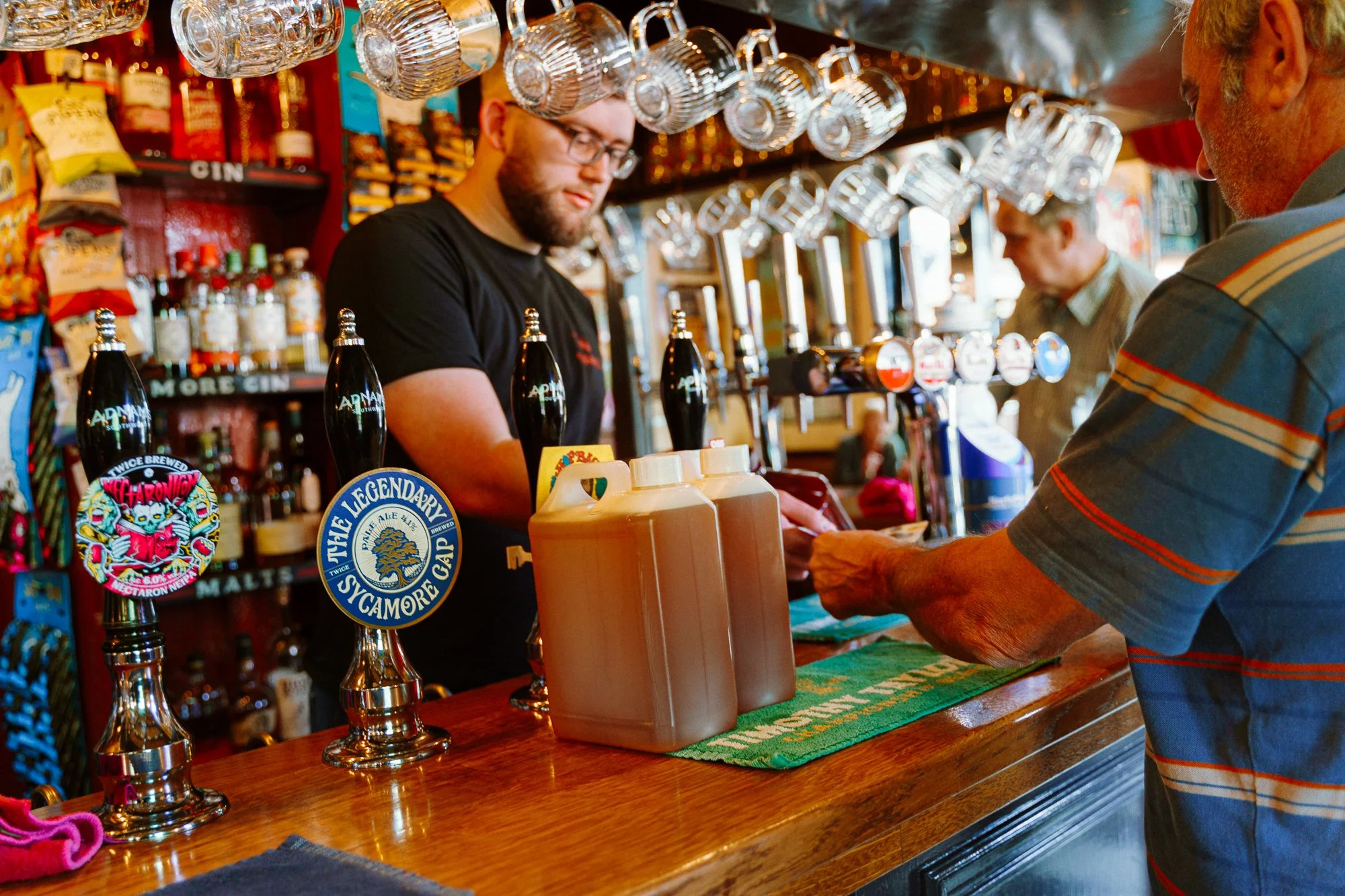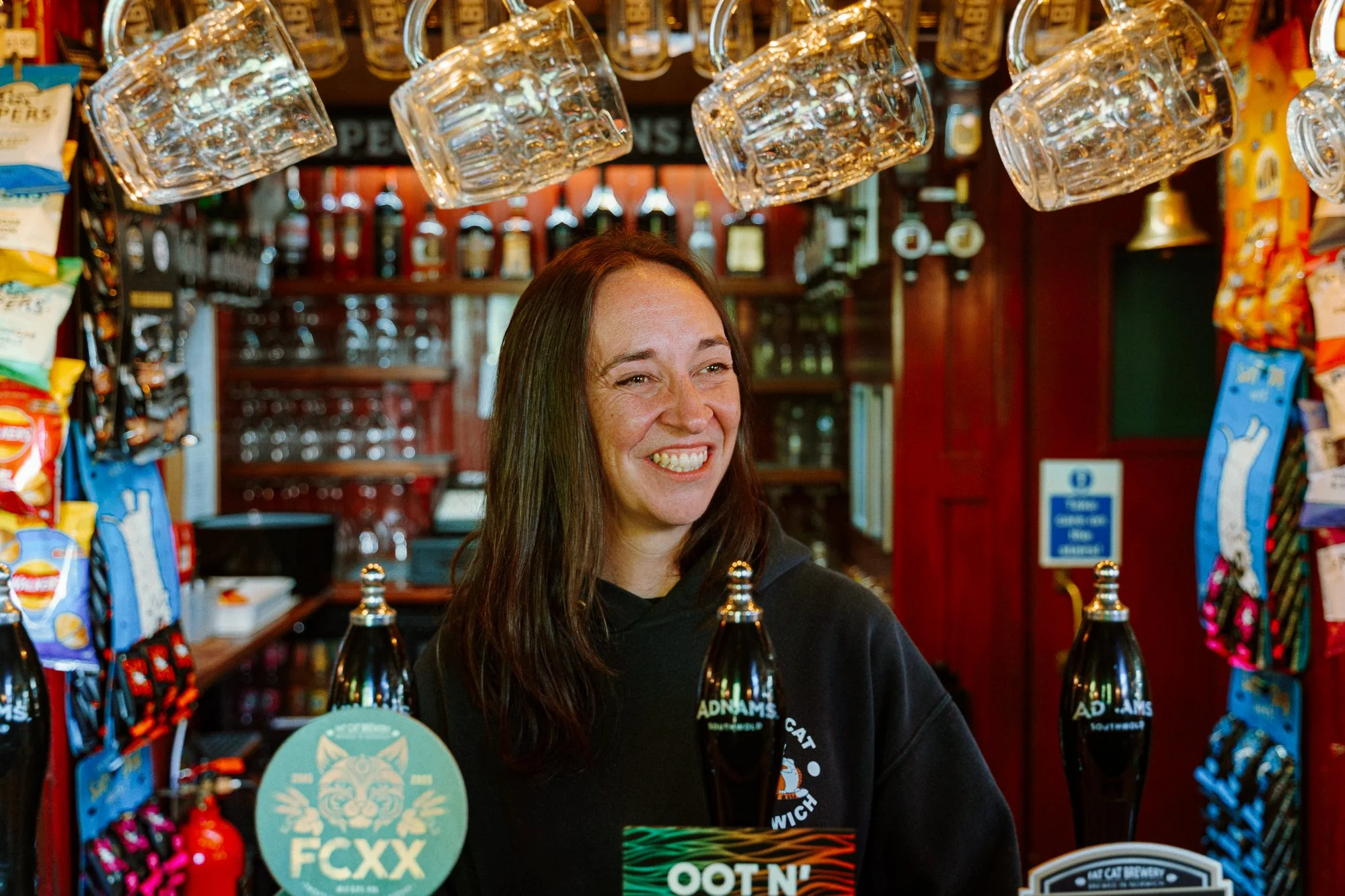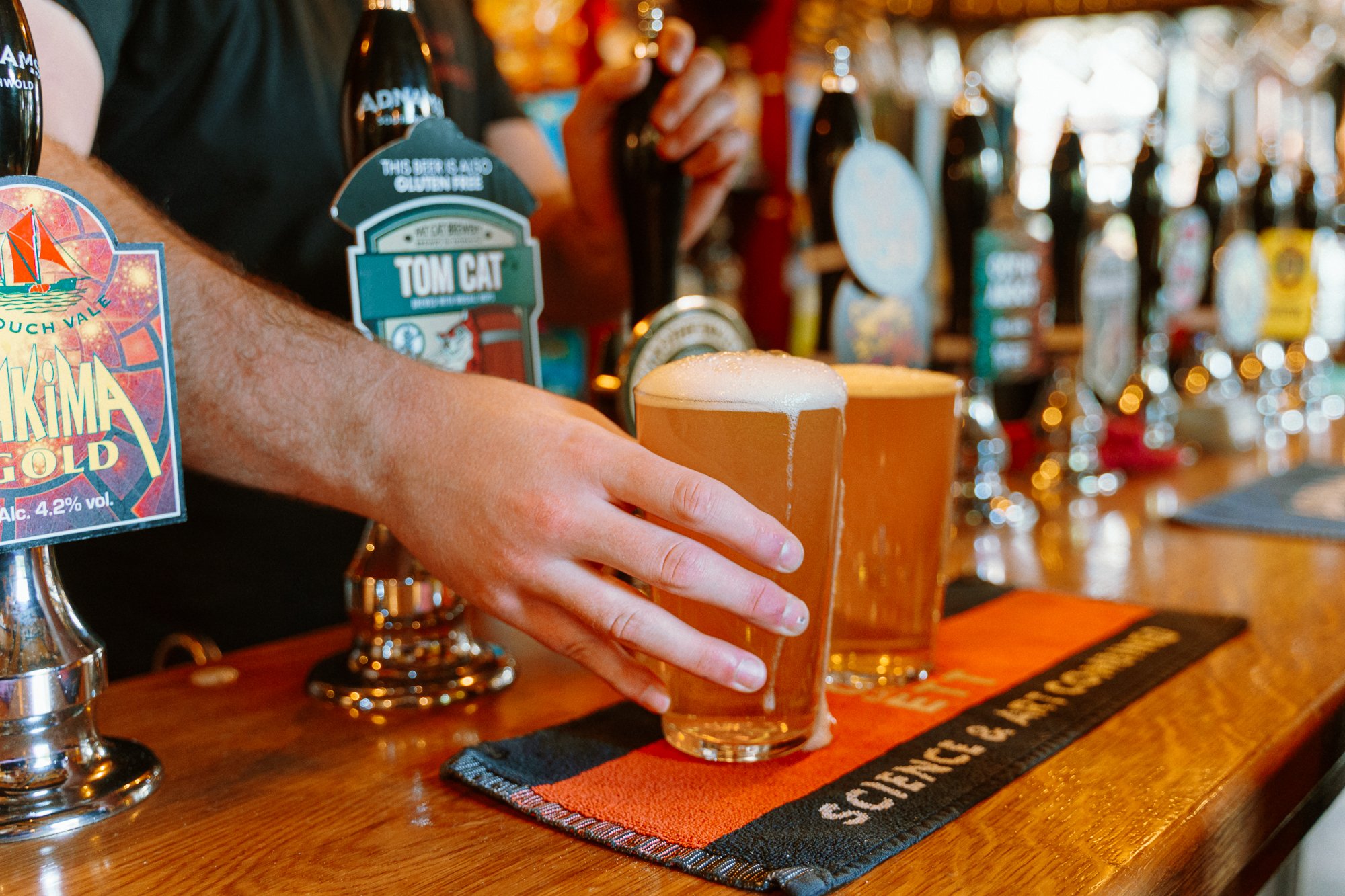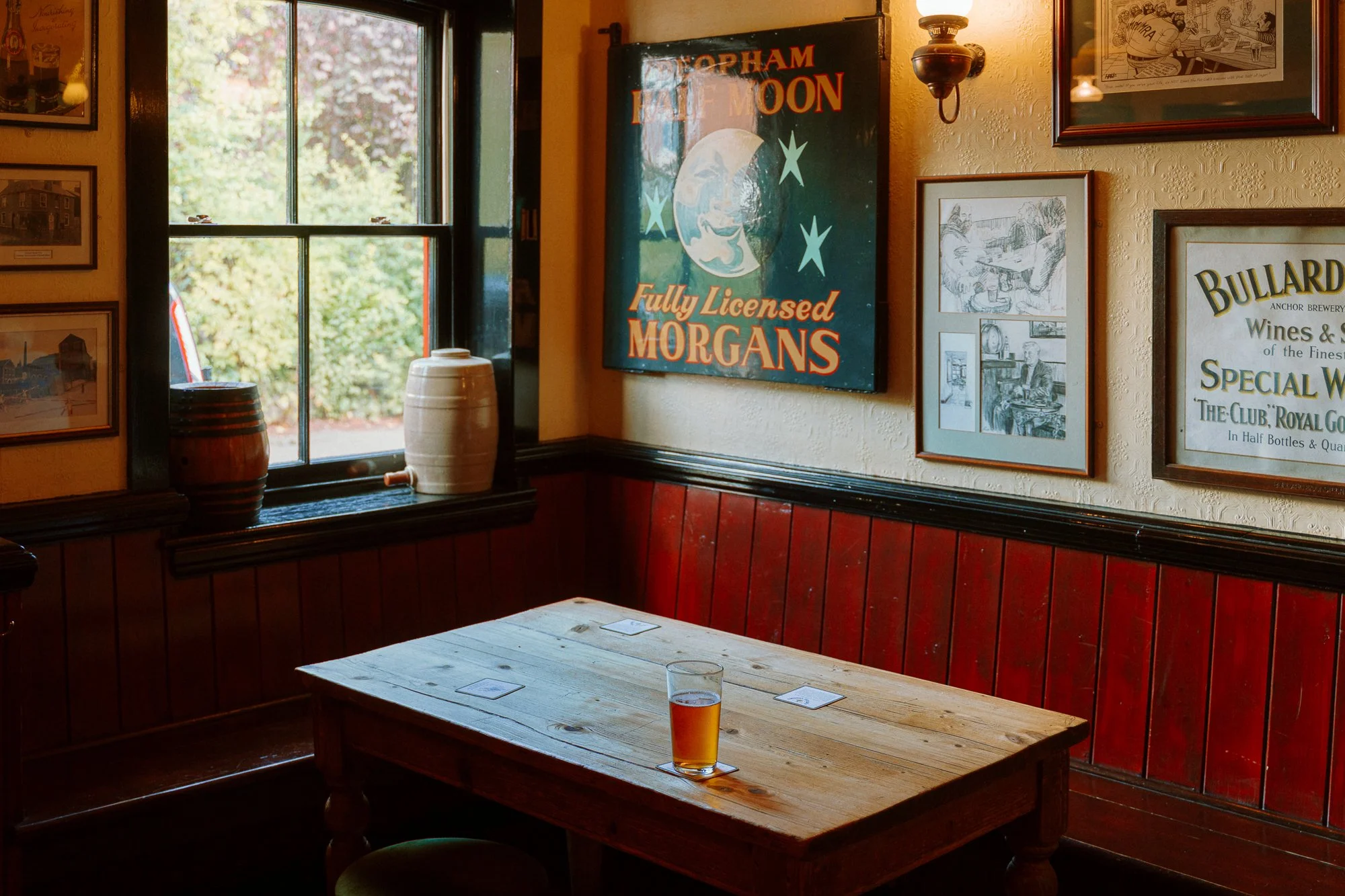Cool for Cats — The Fat Cat in Norwich, Norfolk
Night has fallen over The Fat Cat in Norwich, and I’ve been here long enough to watch the clientele change. I saw the post-work crowd rush in; now, as it thins, I head to the bar to order a pint of Titanic Brewery’s Plum Porter, which gushes from the gravity tap out back into a fresh nonic glass.
As I’m catching up with landlady Marjie Keatley, talking Norwich and London and music and drink, I hear a surprised shout behind me: Here are two friends I was not expecting to meet tonight (one lives in Geneva, Switzerland.) We move to the back room and start reminiscing about old holidays—until I lock eyes with Finn Wright, a former Fat Cat bartender who I haven’t seen in years. We worked some fun shifts here long ago, knocking back halves of Oakham Citra and Green Devil IPA behind the bar with a mischievous, long-lost commander-in-chief nicknamed “Essex Dan.”
This is how it goes at The Fat Cat. Before I know it, hours have passed. This fluid, hazy succession of meetings sums up the place perfectly. Ask any of the Keatleys what The Fat Cat is all about, and they’ll probably respond with two words: beer and conversation.
Photography by Sean McEmerson
“It’s the people in here,” pub regular Mac says when I ask what keeps him coming back to The Fat Cat. “The landlord [Colin Keatley] is special, and people come in because he knows what he’s doing. He’s had a reputation for a long time for running a good ale pub.”
When Colin originally took over and renovated the building, everything was framed around this vision. Meticulously updated chalkboard beer lists wrap around the top perimeter of the bar; ceramic jugs, faded enamel brewery signs, and old glass bottles line the walls; church pews, tiled checkerboard flooring, and maroon-painted half-walls create an abundance of nooks and crannies. There’s no music, no kitchen, and no pretences.
“People want this to be the pub they go to when they’re not doing anything,” explains manager Will Keatley, Colin’s son. “I’ve heard people saying to each other, ‘Are you up to anything tonight?’ and they’ll say, ‘Nah, I’m not doing anything,’ but they’re already out at the pub. It’s a given that they’re going to The Cat for a couple.”
Thanks to that feeling of easy welcome, as well as an extensive line-up across 12 handpumps and 20 barrels on gravity, The Fat Cat is rightly revered as one of the country’s finest cask beer establishments. It’s the jewel in the crown of a city which, as beer writer Pete Brown recently wrote in local CAMRA magazine Norfolk Nips, is “blessed with such a ridiculously large number of phenomenal pubs”.
***
But it wasn’t always that way. Back in 1991, when landlord Colin Keatley and his then-wife Marjie took over what was previously called the New Inn, the pub was a very different place.
“It was a pretty rough pub,” Colin recalls. “Although it was a Victorian pub, it didn’t really have any Victorian architectural features. All the fixtures and fittings, like the breweriana and the stained glass, were added after, and I also decided to create areas and snugs to make the pub feel more traditional. I’ve always loved Victorian-style pubs, and really tried to recreate this style in a way that makes it look like it’s always been there.”
““I’ve always loved Victorian-style pubs, and really tried to recreate this style in a way that makes it look like it’s always been there.””
Today, Norwich has a very healthy beer scene, with dozens of cask-centred boozers, two major beer festivals (City of Ale in the spring and Norwich Beer Festival in the autumn,) and a number of well-regarded local breweries. But back in the early ’90s, the city was still recovering from the destruction caused by brewing giant Watney’s, which swallowed up and closed so many independent brewers that “Norwich was known as ‘a real ale desert’ in the ’60s and ’70s,” as Colin says.
Things started changing in the 1980s, when Colin was running the White Lion and making a name for himself “as someone who liked to champion real ale.” He began making links with breweries around the country, driving his van to places like Burton Bridge Brewery in Burton-on-Trent and Kelham Island Brewery in Sheffield, where he’d pick up barrels to transport back to Norfolk.
Those connections quickly helped The Fat Cat establish a fine reputation. In 1998, the pub won CAMRA’s prestigious National Pub of the Year award, an achievement which 75-year-old Colin looks back on as the highlight of his career.
“It really put the pub on the map,” he explains. “Back in the ’90s, CAMRA were the only real authority on real ale, so it was the best possible recognition you could get.”
In 2004, The Fat Cat became the first pub to win the award twice. And in the years since, it’s picked up countless other prizes, both regional and national (including being named the CAMRA Good Pub Guide’s Beer Pub of the Year a record 11 times).
***
In 2005, a year after its second Pub of the Year victory, The Fat Cat decided to set up a brewery of its own. Colin acquired a site in the north of the city and brought in Ray Ashworth, a legend of the Norfolk beer scene. Ray had created the pioneering brewery Woodforde’s in 1981, and established its bitter, Wherry, as the county’s most popular cask option over the following years.
As a consultant brewer, Ray offered valuable guidance to 18-year-old head brewer Mark Winter, who remains in the role 20 years later. Together, they created a core range that’s still going strong today. Highlights include Marmalade Cat, which won CAMRA’s 2025 Champion Cask Beer of Norfolk, and Tom Cat: a Mosaic-hopped golden ale bursting with sweet mango and passionfruit notes that has emerged as a real crowd favourite.
“Tom Cat is phenomenally popular here,” says Will. “We probably sell six 18-gallon barrels of Tom Cat a week, which is roughly twice as much as our next-biggest seller.” It’s worth doing the maths on that: An 18-gallon kilderkin usually holds about 137 drinkable pints, which means that each week, The Fat Cat sells more than 800 pints of Tom Cat alone. Even for a pub renowned for real ale consumption, that’s remarkable.
Only when you walk through The Fat Cat’s cellars can you truly appreciate the size of the operation. Underneath the bar there’s a well-stocked keg cellar with four cask lines, but it’s out back where the magic happens. There are two gleaming, air-conditioned cellar rooms lined with stillages, each of which holds somewhere between 30 and 40 firkins and pins that are either tapped up or settling down.
““By keeping what we’re doing the same for 30 years, we’ve become fashionable again.””
Beyond the glass washers are multiple store rooms and an additional cellar, where a handful of the pub’s biggest-selling beers are racked up in huge, 18-gallon vessels. The site is vast, responding to a level of turnover established over decades spent serving reliable, perfectly conditioned cask beer.
Crucially, this turnover ensures that each permanent fixture—from Fat Cat’s simple and sessionable Norwich Bitter to Oakham’s zingy, 6% havoc-wreaker Green Devil IPA—remains fresh at all times.
***
Over the years, The Fat Cat has expanded beyond its original location. Following the launch of its brewery, a dedicated taproom, The Brewery Tap, opened in 2011. (The Brewery Tap is now owned and operated separately by Colin’s nephew, Mark White, and his wife Laura, who also recently opened an impressive new micropub named Hop Rocket.)
In 2012, the Keatleys opened The Fat Cat & Canary in the suburb of Thorpe, so named because of its proximity to Carrow Road, the home ground of Norwich City (aka the Canaries). As of 2024, the most recent addition to the feline empire is The Mad Cat, a keg-leaning bar located in an old photocopiers next door to The Fat Cat, which Will views as “another bar under the same roof.”
All these ventures have helped boost The Fat Cat’s profile, while a relationship with the wholesaler Small Beer ensures that the brewery’s ales end up all over the U.K. But the humble charm of the original boozer remains unmatched.
“On the surface we’re an old man’s real ale pub, but there’s a lot going on that you wouldn’t expect,” says Will. “The age range is 18–80: We get loads of students in, we sell a bit of craft beer and cider, and as the day goes on, the average age just gets lower and lower.”
The pub’s more recent popularity with younger drinkers resulted in part from the pandemic, he adds. “Before lockdown, we were possibly getting a bit stale and not finding a new customer base,” Will says. “Sadly a lot of the older regulars were dying, and you were looking at people who were coming in six days a week and thinking, ‘No one’s gonna do that in the future, because people don’t drink like they used to.’”
However, as lockdown influenced people’s drinking habits—and as punters realised they didn’t want to be crammed together into a tight space—the Fat Cat responded by creating a large outside space. “When we reopened, it was packed,” he says. “Within a year, we were out-trading what we were doing the year before lockdown.”
The pub’s cask sales have been strong ever since, Will says, bucking typical downward trends. In an industry that has been facing increasingly hostile conditions in recent years, this is a real success story. The Fat Cat already had an excellent reputation among CAMRA members across the U.K. But it’s been able to boost its local popularity and consistently attract new clientele, thanks to this willingness to meet the moment (and to modernise by working with other local businesses, including Lupa, a cracking new pizza restaurant across the road.)
And yet, for all that The Fat Cat has kept pace with changing customer needs, it hasn’t altered its core offering of well-kept cask ale served with genuine warmth.
“A lot of younger people drink in here now, they like coming in and seeing all the regulars; it makes them feel safe and cosy,” Will says. “The art student crowd, for example, think this is really cool and trendy because it’s old-fashioned. By keeping what we’re doing the same for 30 years, we’ve become fashionable again.”
***
For The Fat Cat, collaboration with other good Norwich pubs is essential. Whether it’s using Colin’s vast supply of furniture and breweriana to renovate The King’s Head (another renowned alehouse in the city), or installing The Vine’s stillage rack and benches during the uncertain Covid-19 days, it maintains a solidarity with local venues that hold a similar ethos.
“I don’t have much time to go drinking, so when I get a chance, I go to The Fat Cat,” says Aey Allen, landlady of The Vine. This little boozer in central Norwich is known for pairing local ales like Tom Cat and Oakham JHB with its fragrant, fiery Thai food, and Fat Cat brews have been core to Aey’s offering for a while.
“I’ve been here for 17 years now, and I met Colin very early days,” she explains. “He came here for my beer festival, and we just clicked. He’s like me: We both work really hard to look after our business.”
There’s also a sense of trust and confidence placed in staff that means they stick around. At The Fat Cat, new employees are quickly thrust behind the bar to contend with a heaving Friday night trial shift. Before long, they’re learning how to describe different flavours, recommend beers to customers, tap and vent barrels, change kegs, and keep the cellars spotless.
“You grow an appreciation of the beer, even if you don’t start with one,” says Vicci Moles, a pivotal member of The Fat Cat staff who once helped show me the ropes. “You’re tasting everything all the time, you’re talking to people about beer a lot, so you do need to learn.”
Vicci first got a job at The Fat Cat when she was 18, and though she moved away for a time, she kept finding her way back. “Once you’ve worked here, it’s difficult to find the same sense of team or the same sort of atmosphere in other pubs,” she says. “Colin doesn’t micro-manage, he just trusts us to know what we’re doing and get on with it.”
““Once you’ve worked here, it’s difficult to find the same sense of team or the same sort of atmosphere in other pubs.””
I understand the feeling. I also joined The Fat Cat when I was an 18-year-old bartender trying to scrape together some extra cash for a holiday, or more likely, a crate of lager to drain in a local park. I slung a CV into the boozer down the road and got a trial shift the same week. What I hadn’t quite bargained for was the realisation that there was far more to beer than Stella and Carlsberg.
***
During a trip back home to Norwich, I decide to swing into The Fat Cat for a quick one. I grab a Yakima Gold, my go-to: always well-conditioned, bright and zesty, with a foamy white head that could convince you it’s been pulled through a sparkler.
Soaked into the fabric of this place are many fond memories. Here, I sat and sipped Crouch Vale Brewery’s Yakima Gold and Dark Star Brewing Co.’s American Pale Ale with my late dad during his final few months, knowing our time was limited but finding respite from that terrifying prospect in a pint of something crisp, bitter, and restorative.
He was the first person I knew who showed beer the reverence it deserved, so each time I settle into a corner of The Cat (he always liked the big rectangular table by the old fireplace, which is surrounded by colourful tin signs advertising obscure old stouts and milds), I’m keeping that memory alive.
Of course, I’m extremely biased—I grew up five minutes down the road, worked behind the bar, and have spent many happy hours on the other side of it—but I firmly believe that The Fat Cat is the best cask beer pub in the world.
It’s not just its vast range of ales. It was here I learned to build friendships, to grasp the value of a hard day’s graft, to converse with people from different walks of life, and to understand the crucial role that hospitality plays in bridging social divides and creating community. Throughout it all, The Fat Cat has shown the long-term value of crafting a clear and authentic pub identity.
“It’s amazing that we’re still regarded as one of the best pubs out there,” Colin says. “I’d like to think that we could possibly win National Pub of the Year for a third time. Then I can retire a happy man.”




